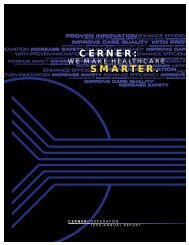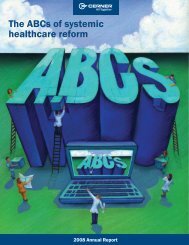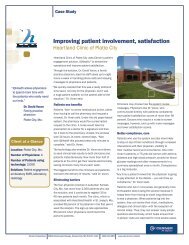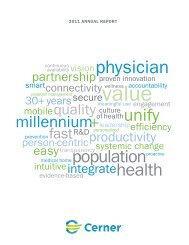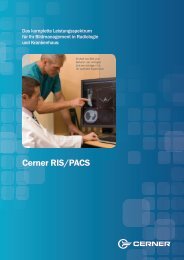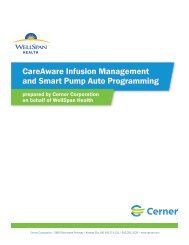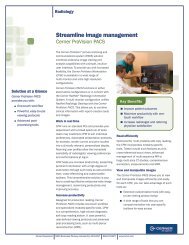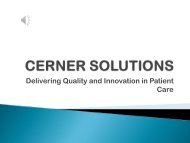Download the Full Report - Cerner Corporation
Download the Full Report - Cerner Corporation
Download the Full Report - Cerner Corporation
Create successful ePaper yourself
Turn your PDF publications into a flip-book with our unique Google optimized e-Paper software.
GENERAL ELECTRIC AND CERNER<br />
thoracic<br />
axillary artery<br />
brachial artery<br />
celiac trunk<br />
gastric artery<br />
splenic artery<br />
renal artery<br />
eric<br />
left subclavian artery<br />
After an extensive evaluation of <strong>the</strong> future,<br />
GE Medical Systems, a leader in <strong>the</strong> radiology<br />
field, and <strong>Cerner</strong> announced a partnership in<br />
1998 to develop <strong>the</strong> next generation of solutions<br />
for <strong>the</strong> radiology suite. Through this partnership<br />
<strong>Cerner</strong>’s industry-leading RadNet Radiology<br />
Information System will be integrated with<br />
GE Medical Systems’ Picture Archive and Communication<br />
Systems (PACS) technology.<br />
GE Medical Systems, through its own sales force,<br />
will market this new solution. “We’ve built a<br />
relationship with <strong>Cerner</strong> because we want to be<br />
involved long-term with an organization that<br />
really understands how information moves<br />
around <strong>the</strong> enterprise,” says Vishal Wanchoo,<br />
General Manager, Integrated Imaging Solutions,<br />
GE Medical Systems.<br />
Radiologists and o<strong>the</strong>r clinicians will benefit from<br />
<strong>the</strong> new solution as <strong>the</strong>y access information and<br />
images in a seamless fashion on common workstations.<br />
Healthcare organizations will benefit<br />
from improved productivity and enhanced decision<br />
making by clinicians, and <strong>the</strong> elimination of<br />
unnecessary technology investment.<br />
l artery<br />
(Knowledge + Technology + People) + (Time + Place) = Optimal Health Outcome<br />
<strong>Cerner</strong> makes it possible for health organizations to maximize <strong>the</strong>ir current investment while taking incremental<br />
steps toward building an information infrastructure. Our unique architecture is completely open, allowing <strong>Cerner</strong> systems<br />
to connect easily to <strong>the</strong> legacy systems that generate <strong>the</strong> majority of a health organization’s information. At <strong>the</strong> end of<br />
1998, <strong>Cerner</strong> systems openly interfaced to more than 120 foreign systems, through 2,500 active interfaces.<br />
Information technology departments that must run a patchwork of different computing platforms and operating<br />
systems require highly skilled, expensive technical professionals to maintain each of <strong>the</strong>m. HNA Millennium is different.<br />
By using one operating system and one database across all applications, HNA Millennium streamlines systems management<br />
and can substantially reduce an organization’s labor costs for systems support. HNA Millennium supports both<br />
IBM ® AIX and Compaq OpenVMS computing platforms and utilizes <strong>the</strong> industry leading Oracle ® database. At <strong>the</strong><br />
forefront of innovation, <strong>Cerner</strong>’s approach combines multi-tier client/server solutions with thin client and web<br />
technologies to deliver <strong>the</strong> right tool for <strong>the</strong> right job.<br />
C ERNER<br />
CORPORATION<br />
ANNUAL R EPORT 13



